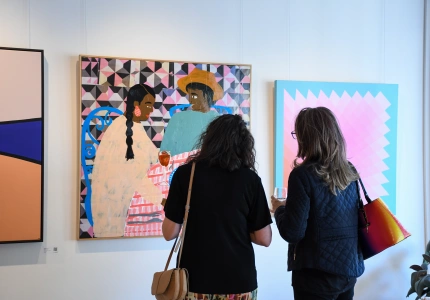
Right now, your ability to turn a concept into a reality is limited only by your imagination. Generative artificial intelligence (AI), powered by large language and diffusion models like Dall-E and Midjourney, enable us to take the most outlandish idea – David Bowie riding a rainbow alligator while drinking a strawberry milkshake – and turn it into a cohesive collection of pixels with as much effort as it took to open this article on your device.
This is either a dystopian hellscape or a field of dreams depending on your outlook. You’d think I, as the founder of Bluethumb, Australia’s largest online art marketplace, would fall neatly into one of these two viewpoints – but the reality is far more nuanced.
While the rise of AI has thrown up a host of ethical and philosophical concerns for creativity – from the unlicensed use of artists’ intellectual property to the very way our culture values creativity – it has also shown us the potential benefits of multiplying human ability in other sectors like health and climate.
In the art world, AI presents a unique set of questions for the public, collectors and artists alike. What is the true cost of human expression? Does the value of art change if a machine helped to create it? These are deeply subjective questions without black and white answers. But, after helping our artists sell more than 100,000 original artworks since I started Bluethumb in 2011, I feel sure of one thing: true originality must be protected and valued for the fleeting, magical and challenging phenomenon it is.
This is because truly new ideas are what propel us forward, expand our worldview and break our inertia. New ideas are often repellent, too. In fact, we are evolutionarily hardwired to respond to something we have never encountered as dangerous; it’s what has kept us safe. Truly new creative ideas trigger this in all of us, whether we admit it or not. The relationship I have with my most beloved albums, books, artworks and even technologies started out with me disliking – even hating – them. As a result, I’ve learnt to pay attention to design, art, music I’m initially shocked by.
When new ideas are expressed as art, it’s a form of alchemy. Actor Ethan Hawke elegantly summarised the importance of art in society as helping us make sense of the big things that happen to us and nourishing the part of our soul that exists outside logic and reasoning. A machine-made piece of art, made from trillions of pre-existing data points, will never have the same effect on us because it lacks the touch of divine at the heart of a genuinely new idea.
Our platform exists to serve artists, to get more art into the world – but not at the cost of human-led creativity. This is why we recently pledged to sell only human-made artwork. This is something we have done since we first started selling art more than a decade ago, but as AI becomes an increasingly inevitable part of life, it’s important that some things are clearly defined, protected and valued.
Our community feels strongly about this, too. We recently surveyed more than 1,500 Australian artists and collectors and found that not only do 95 per cent of collectors demand transparency about the use of AI in creating artworks, close to 90 per cent told us that handmade art holds intrinsic value that AI cannot replicate. These buyers understand that AI has a potential negative impact on artists’ rights, citing concerns such as plagiarism and the knock-on effects on artists’ livelihoods.
On the other side of the canvas, artists too are concerned. Three-quarters of artists surveyed view AI as a threat to the art world, worrying it may undermine their creative processes and career sustainability; 70 per cent continue to prioritise handmade art over experimenting with AI technologies; and 65 per cent worry about AI copying their styles and works.
It’s important to note that in the world of art, the conversation around AI isn’t just focused on large language models spitting out even more convincing interpretations of the prompts behind them. There are reasons to be optimistic about its impact too, with AI-powered tools that help create efficiencies, accessibility and opportunities for collaboration and integration. AI can help curators, collectors and artists overcome cultural barriers, aid in research and translation, even to create more transparency in art pricing. Indeed, half of the artists we surveyed are curious about AI’s potential benefits to their practice, despite 70 per cent saying they never use it.
There is a future in which AI-powered technology can strengthen our innate creativity, not undermine it. After all, the invention of the camera liberated the artist by giving permission to capture the previously unseen, and I’m quite sure AI will have the same effect. But you cannot distil all of humanity’s creative output, feed it into a machine and expect to find something genuinely innovative. At best, you get a novel remix.
The intersection of creativity and technology is at the root of so much innovation. Many of my creative heroes have been avid technologists and innovators: Walt Disney invented multiplane camera animation; Andy Warhol pushed the limits of commercial screen-printing into art; David Bowie constantly reinvented himself while the world played catch up. Technology may never be able to distil the genius of Bowie into a rebooted 2.0 version, but it can multiply our human ability to transform our world for the better. As long as the ideas – and the art they create – remain human.
This post was originally published on this site be sure to check out more of their content





